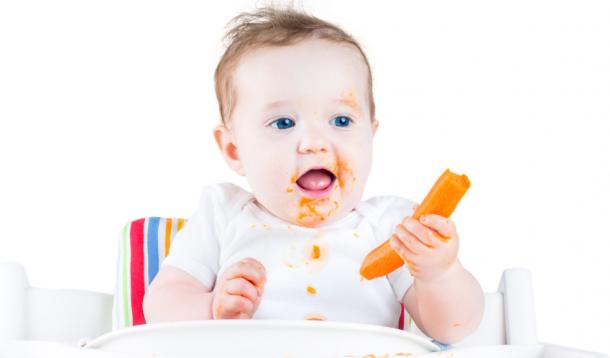
My third baby is six months old today, and about a week and a half ago, he tried his first real food. Want to know what it was? Salmon! Not pureed, not mashed, and not mixed with breastmilk. Just barbequed salmon with a bit of olive oil brushed on before grilling, in pieces that were big enough for him to pick up and soft enough to easily break apart in his mouth.
The reason why it was salmon? It's extremely nutritious, rich in iron, Omega-3 fatty acids, protein and flavour. And it was what we happened to be serving the night that our baby reached out and grabbed a piece off of my plate as we were eating dinner. I thought "this is the perfect first food for you — let's start solids!" After all, he had been holding himself up for a couple of weeks and was clearly interested in real foods.
He was ready.
As a Dietitian, I often receive questions about starting solids — one of the most common ones being "what is the best first food" for my baby? There is a lot of confusion (and misinformation) out there when it comes to starting solids (when to do it, how to do it and what to serve), so I want to provide you with the most up-to-date information available and my suggestions for giving your baby the best start to real foods:
Traditionally, iron-fortified single-grain cereal (think rice cereal) thinned out with breastmilk or formula was the gold-standard first-food for baby. Is it the best first food though? Not necessarily. Alice Callahan, author of Science of Mom, (a fantastic book that I would highly recommend to parents) explains on her blog that "baby cereals are often recommended as first foods, but this is based more on tradition and culture than on any scientific evidence. There is no reason why you can’t introduce those great heme sources of iron (meat, poultry, fish) as first foods, and in fact, this is now recommended by the AAP [*and the new Canadian Infant Feeding Guidelines]."
The iron found in infant rice cereals is non-heme iron, which is less bio-available (not absorbed as efficiently) than heme iron sources such as meat, fish, eggs, and poultry. That being said, iron-fortified single-grain cereals such as barley or oat cereals can still be good first food options if parents feel more comfortable going this route. It's really a personal choice. Fortified infant cereals are safe, convenient and shelf-stable. They can come in handy if your baby attends daycare or if you're in a rush and want to make sure she is getting her quota of iron for the day. But some parents become too dependent on these cereals, which means their babies could be missing out on other nutrients. Baby cereals, although nutrient-fortified, don't stack up as well nutrition-wise as other iron-rich foods such as meat, fish and eggs that also contain protein and fat — two important nutrients for baby. If infant cereal is your baby's first food, make sure that you're also introducing a variety of other foods, flavours and textures within the first few months of starting solids.
Iron-rich foods should be introduced right from the get-go, as your baby's iron needs increase around six months of age. That being said, there is no rule saying that your baby's first food can't be avocado, carrots, green beans or banana. You just want to make sure that iron-rich foods are introduced right around six months of age as well, and served daily. Iron is an important mineral for brain health and red blood cell production, and although babies have a reserve built up from being in the womb, at about six months it starts to deplete, therefore a daily dose of iron-rich solid food is needed to keep your baby physically and developmentally healthy. Babies between six and 12 months of age should be offered iron-rich foods at least twice a day (one to two small servings). Soft and tender pieces of meat or finely minced, ground or mashed cooked meat, de-boned fish, poultry, well-cooked whole egg, beans, and lentils are great first foods. Add in a serving of plant-based, non-heme iron (lentils, beans, spinach) and your baby will be getting everything he needs iron-wise. No infant cereal needed.
In short, yes. Parents should be aware that rice-containing foods (such as infant rice cereal) do contain arsenic, as well as other metallic elements such as mercury and cadmium. Unfortunately, the rice plant is really effective at soaking up these elements out of the soil and ground water. To make matters worse, the rice plant is very efficient at absorbing inorganic arsenic (a form of arsenic that lacks the organic element carbon), which is much more harmful to humans than its organic counter-part. And unfortunately for health-conscious parents, brown rice has even higher concentrations of arsenic than white.
Arsenic is a known carcinogen and can also cause cardiovascular, respiratory, metabolic and immune-related health issues. In a new study out published in JAMA Pediatrics, the parents of 759 infants were interviewed at various points in the first year, specifically about their babies' rice and rice product intake. At 12 months of age, the urinary arsenic levels were higher for those infants who ate infant rice cereal compared with those who did not eat rice or rice products. Because babies and young children are more sensitive to the harmful effects of inorganic arsenic, and consume higher amounts (per kilogram of body weight) compared to adults, too much rice cereal may pose a health risk. And iron-fortified infant rice cereals aren't the only food we should be concerned about--there are also lots of rice-containing toddler foods that are on the shelves including crackers, puffs and cereals. The good news is, the FDA has recently set limits on the amount of arsenic in these infant/toddler foods, which is one step in the right direction.
No. The occasional serving (once or twice a week) of rice cereal, or whole rice — whether brown or white — is likely completely fine when included in an otherwise balanced and nutritious diet. Should you serve rice cereal to your baby daily? Probably not considering the growing amount of evidence that we're seeing on arsenic and rice cereal. Make sure that your baby's diet is varied and includes those iron-rich whole foods mentioned above, vegetables, fruits, healthy fats and whole grains such as oats, barley, and quinoa to ensure that all nutrient requirements are being met.
For more information on the arsenic and rice connection, check out this great blog post by Alice Callahan, PhD and Author of the book Science of Mom called The Whole Truth About Infant Rice Cereals and this article, Ten Things to Know About Arsenic and Rice by Debora Blum.
For more information on when and how to introduce solids (and some of the challenges you might come across when feeding your baby), check out this post highlighting the latest infant feeding guidelines, and my favourite finger foods to give to your baby. Here's a post that walks you through the when's, where's, how's and what's of starting solids and another one discussing the benefits of baby-led weaning.
If you're looking for free daily advice on kids nutrition and feeding, as well as yummy and easy kid-friendly recipes, visit my Facebook page.
![]() RELATED: 3 Fast and Healthy Finger Food Recipes for Your Baby
RELATED: 3 Fast and Healthy Finger Food Recipes for Your Baby
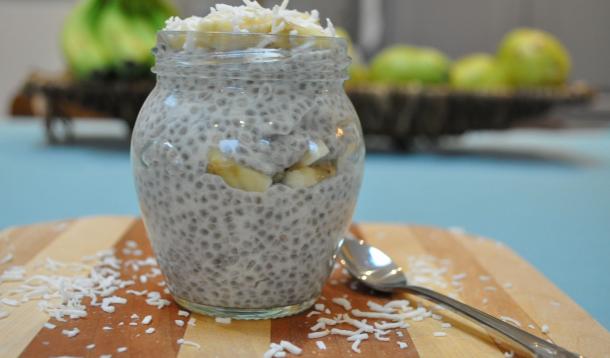
Some of my most popular recipes contain chia seeds, including these chocolate chia protein balls, these flourless chocolate zucchini muffins, and this chocolate peanut butter chia pudding. Wait... they also all contain chocolate, so maybe that better explains their popularity...
Regardless, chia seeds are my new favourite ingredient. They are extremely versatile, taking on the flavour of whatever you're pairing them with, adding some texture and color to an otherwise bland recipe and of course adding loads of nutrition. These little tiny black jewels are packed full of nutrition, including protein, fibre, Omega-3 fatty acids, calcium, magnesium and zinc. Just one ounce of chia seeds (about 2 tablespoons) contains about 10 grams of fibre and almost 5 grams of protein—both of which help us feel fuller longer—contributing to healthy weight management.
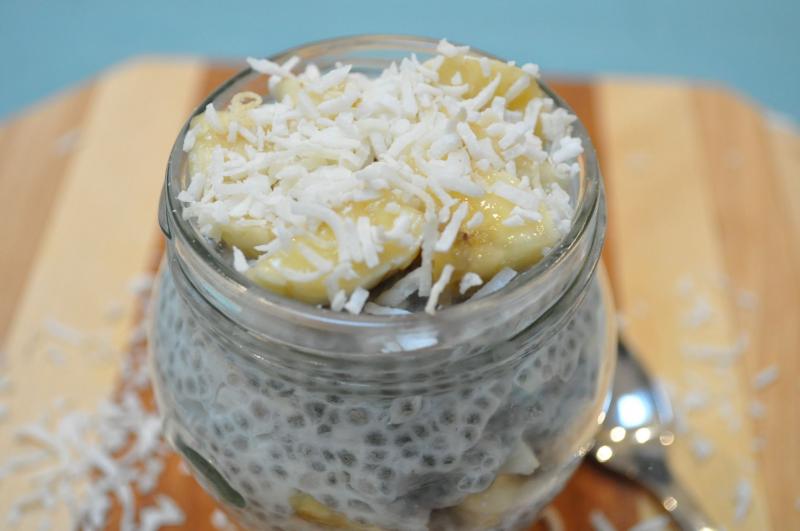
As you can probably rell, I’ve been on a huge chia seed kick lately, adding them to smoothies, yogurt parfaits, homemade granola bars, breakfasts and just about anything else that could use an extra boost of nutrition.
The soluble fibre found in chia seeds can also help to keep blood sugar levels stable and can help protect against many chronic diseases such as diabetes, heart disease and colon cancer.
My kids absolutely loved my chocolate peanut butter chia pudding (linked above), so I decided to test out another pudding recipe using one of my favourite flavour combinations; coconut and banana, for a more tropical feel. The kids loved it just as much and we will definitely be making it again!
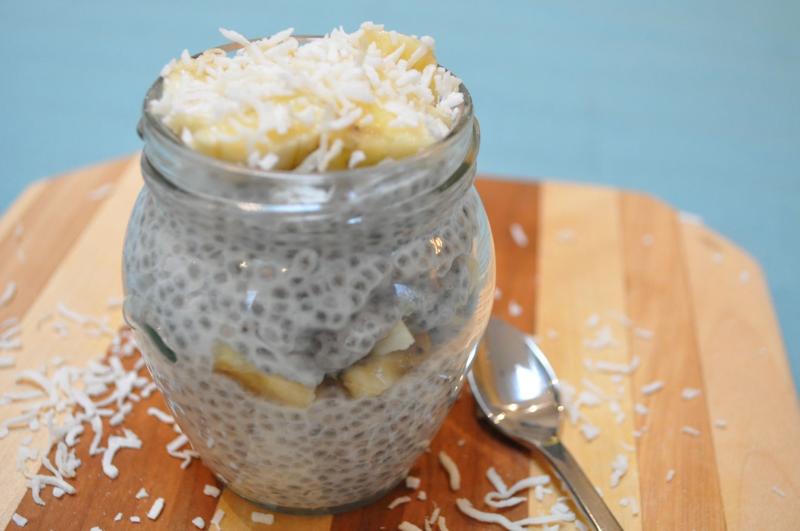
Ingredients
Directions
 Pour coconut milk and honey into a small saucepan and set over medium heat on the stove, stirring often until steaming (about 5-10 minutes).
Pour coconut milk and honey into a small saucepan and set over medium heat on the stove, stirring often until steaming (about 5-10 minutes).
 Remove from heat and transfer to a glass bowl. Stir in chia seeds, shredded coconut and vanilla extract and whisk together. Let sit for about 10 minutes at room temperature.
Remove from heat and transfer to a glass bowl. Stir in chia seeds, shredded coconut and vanilla extract and whisk together. Let sit for about 10 minutes at room temperature.
 Once cooled, cover with plastic wrap and put in the fridge to chill for at least 12 hours.
Once cooled, cover with plastic wrap and put in the fridge to chill for at least 12 hours.
 After the 12 hours, remove from fridge, stir in greek yogurt and whisk until incorporated.
After the 12 hours, remove from fridge, stir in greek yogurt and whisk until incorporated.
 Optional: transfer to a good quality blender and blend until smooth (this might work better if you want a smoother pudding). Hint: use white chia seeds for a more pleasing colour.
Optional: transfer to a good quality blender and blend until smooth (this might work better if you want a smoother pudding). Hint: use white chia seeds for a more pleasing colour.
 Serve in small dishes with banana slices and shredded coconut on top!
Serve in small dishes with banana slices and shredded coconut on top!

For more kid-friendly and delicious recipes (as well as daily nutrition tips for babies, kids and Moms), head over to my Facebook page!
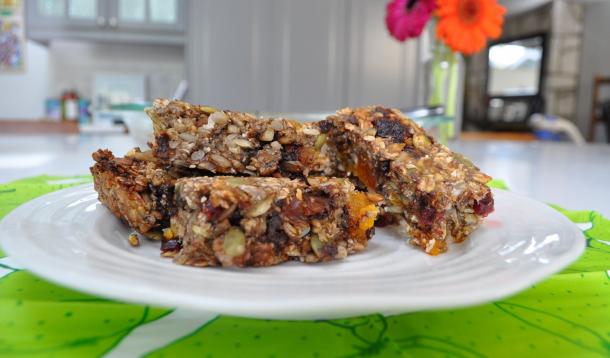
Finding healthy snacks I feel good about serving, and that my kids love to eat, is no easy feat. And this is why I've fallen into the not-so-great habit of sending store-bought granola bars with my son to school in the past; the thought of making homemade granola bars seemed daunting and way too time-consuming. Until I finally decided to start making them that is.
Don't get my wrong, I know that there's nothing wrong with offering my kids healthy store-bought snack foods once in a while, but I've always felt better making things like cookies, granola bars, muffins and other baked goods from scratch. After all, I know exactly what is in them!
Homemade granola bars also make for great one-handed snacks for busy Moms!
My friend and Dietitian colleague Cara Rosenbloom is a culinary whiz and has recently written her first cookbook entitled "Nourish." She and her co-author chose to focus on family-friendly recipes using beans, nuts and seeds in their book--three nutrient powerhouses. Not surprisingly, Cara included a killer granola bar recipe in her book that packs a punch nutritionally speaking, but is also delicious and kid-approved. As a bonus, there are no nuts or nut butters, which make them safe to send to school. What I find astounding about these bars is that they are held together by only one nutritious ingredient: mashed bananas!
The various seeds that are included offer both protein and fibre — two nutrients that keep tummies full and energy levels steady and stable, and because of the bananas and dried fruit included, there is absolutely no added sugar needed. My daughter took one look at the picture inside the cookbook and asked if we could make them NOW.
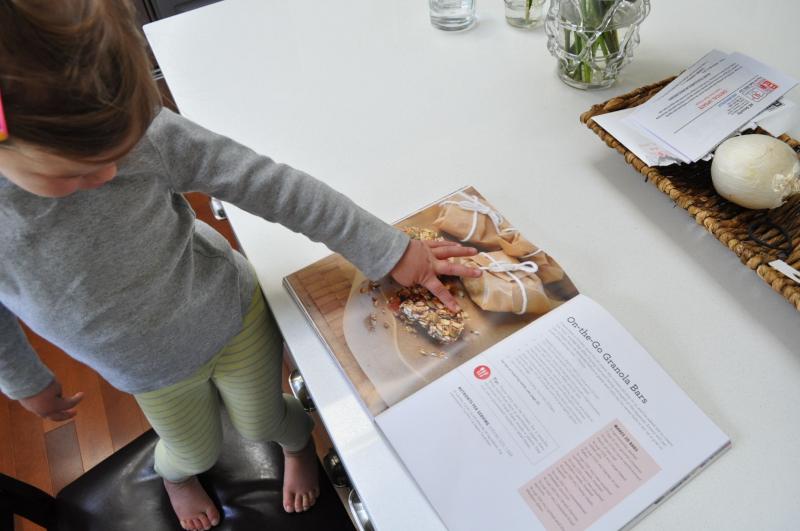
Ingredients
Directions
 Preheat oven to 350 F. Line a 9X13-inch baking sheet with parchment paper.
Preheat oven to 350 F. Line a 9X13-inch baking sheet with parchment paper.
 In a large bowl, mash the banana until smooth. Add cinnamon, vanilla, salt, oats, and barley flakes and stir well.
In a large bowl, mash the banana until smooth. Add cinnamon, vanilla, salt, oats, and barley flakes and stir well.
 Add the toasted seeds, coconut, cherries, apricots, and dates to the banana-oat ixture and stir until thoroughly combined.
Add the toasted seeds, coconut, cherries, apricots, and dates to the banana-oat ixture and stir until thoroughly combined.
 Spoon mixture into a baking dish. Press down until compact and even. Bake 25-30 minutes until firm and lightly golden along the edge.
Spoon mixture into a baking dish. Press down until compact and even. Bake 25-30 minutes until firm and lightly golden along the edge.
 Let cool about 10 minutes. Slice into 20 bars.
Let cool about 10 minutes. Slice into 20 bars.
Recipe From: Nourish: Whole Food Recipes featuring Seeds, Nuts and Beans, by Cara Rosenbloom, RD and Nettie Cronish

If you liked this recipe, you may also like these Chocolate Chia Protein Balls and well as these Sweet and Salty Lentil Chocolate Chip Granola Bars
![]() For more easy and healthy recipes (as well as nutrition tips for families and kids), visit my Facebook page where I post daily!
For more easy and healthy recipes (as well as nutrition tips for families and kids), visit my Facebook page where I post daily!